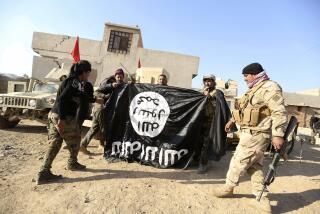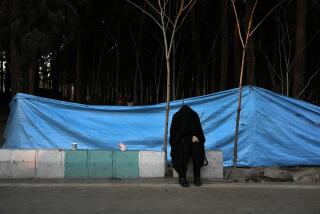Suicide bombers kill 71 at Baghdad shrine
- Share via
BAGHDAD — Two bombers detonated suicide vests Friday outside a golden-domed religious shrine in Baghdad and killed at least 71 people, raising the death toll in two days of attacks on Shiite Muslims in Iraq to 159 and reviving fear of a return to sectarian war.
The attacks at the Imam Musa al Kadhim shrine in the northwest of the capital increased concern that the Sunni Arab insurgency is regrouping just as U.S. forces are preparing to withdraw from Iraq’s cities and President Obama seeks to shift resources away from Iraq toward Afghanistan.
The violence was reminiscent of the sustained campaign of bombings against Shiite targets, particularly mosques and markets, that escalated throughout 2005 and eventually provoked a fierce backlash from Shiite militias. It was the bombing in February 2006 of another Shiite shrine, in Samarra, 60 miles north of the capital, that escalated the conflict into civil war.
It is too early to say whether the recent increase in violence marks the beginning of a new trend, or just another of the many bloody blips likely to characterize Iraq as U.S. forces withdraw, said Joost Hiltermann of the International Crisis Group. Either way, he said, it is unlikely that the violence will interfere with Obama’s plan to pull out from the cities by the end of June, to withdraw U.S. combat forces by the end of August 2010 and all U.S. troops by the end of 2011.
“I don’t think the U.S. has any appetite to stay, whether the violence is up or down, and I’m not sure President Obama is going to change his mind,” Hiltermann said.
At the same time, the violence could undermine Iraqi Prime Minister Nouri Maliki’s image as a tough leader as the country prepares for national elections late in the year.
Maliki ordered the detention of the police commander in charge of the area at the time, and the suspension of all other officers on duty. He also appointed a commission to look into what appears to be a coordinated escalation of violence.
The U.S. military commander in the region, Army Gen. David H. Petraeus, said in testimony before Congress on Friday that the bombings show the situation in Iraq is still “fragile and reversible.” He said that more such attacks are likely.
The U.S. military has evidence that four other recent suicide bombers were Tunisian nationals, Petraeus said, suggesting a return to Iraq by the foreign Islamist fighters held to be responsible for most suicide attacks early in the insurgency. Another person who facilitated the actions of the four has been captured, he said.
Police said the two bombers Friday struck minutes apart outside separate gates of the shrine, where one of the 12 holy imams of Shiite Islam is buried. It draws thousands of visitors daily from around the world and is closely guarded by police and army checkpoints.
Pilgrims and worshipers were streaming toward the shrine to attend Friday prayers when the first bomber struck in an alleyway leading to one of the gates. Witnesses described scenes of panic as people tripped over bodies and upended market stalls while trying to escape through narrow passages.
The second bomber detonated his vest moments later amid a group of Iranian pilgrims walking to the shrine along a main shopping street. At least 25 of those killed by the second blast were Iranian, police said.
Iranian pilgrims were also the target of one of two bombings Thursday that killed 88 people, more than initially reported. In one of those assaults, police said, a suicide bomber attacked crowds of Iranian pilgrims at a restaurant near the border with Iran, killing 53 Iranians and four Iraqis. In the other attack, a suicide bomber killed 31 people lining up for food aid in a Shiite neighborhood of Baghdad.
Iran’s influence in Iraq since the fall of Saddam Hussein and the election of a Shiite-led government has been a leading source of discontent among many Iraqi Sunnis, not only those associated with the insurgency.
Witnesses to Friday’s bombings said they believed that whoever was behind the attacks was intent on provoking another round of sectarian strife.
“Such incidents are aimed at creating the conditions for a return to sectarian war, and that is what they want. But with the help of God we will not see those days again,” said Hussein Saleh, 46, whose cosmetics store is 25 yards from the site of the second blast.
Prime Minister Maliki has dramatically increased pressure on a U.S.-backed Sunni paramilitary movement that split with the insurgency and helped turn the tide against the militant group Al Qaeda in Iraq. His government has arrested some leaders and forced others into exile, raising speculation that paramilitary members might return to anti-government violence.
But paramilitary members also have been targets in this latest wave of violence. One leader was killed in a bombing Thursday in Diyala province and nine members were killed April 11 in a suicide bombing south of Baghdad. Suicide bombings are considered a hallmark of Al Qaeda in Iraq, which the U.S. military believes is led by foreign fighters.
The U.S. military says it has made great strides in preventing the incursion of foreign fighters and that in recent years most suicide bombers have been Iraqi. The Iraqi government blamed Al Qaeda in Iraq, in collusion with remnants of Hussein’s former Baath Party, for this latest wave of attacks.
“We think there is a coordination, maybe old, maybe new, between the Baath Party and Al Qaeda,” said Ali Allaq, a Shiite legislator who is a close advisor to Maliki.
“Both sides are trying to prove they still exist after the major setbacks they have faced, and they are looking for easy targets.”
--
Times staff writer Raheem Salman contributed to this report.
More to Read
Sign up for Essential California
The most important California stories and recommendations in your inbox every morning.
You may occasionally receive promotional content from the Los Angeles Times.










